MARIANI’S
Virtual Gourmet
September
27, 2020
NEWSLETTER
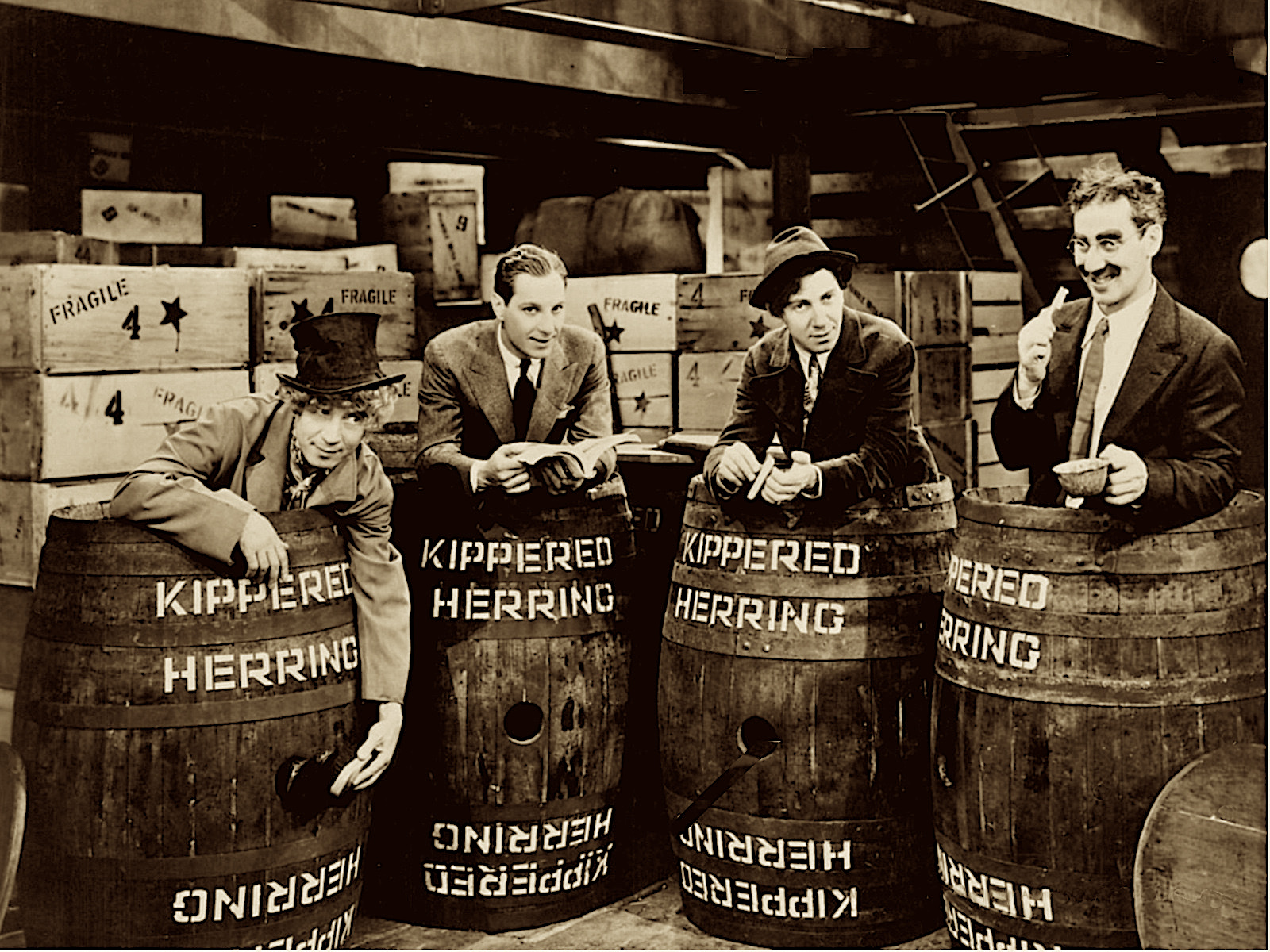
Harpo, Zeppo, Chico and Groucho Marx in "Monkey Business" (1931)
❖❖❖
IN THIS ISSUE
HOW WE ALL CAME TO LOVE RAW FOOD
By John Mariani
NEW YORK CORNER
LOVE AND PIZZA
CHAPTER TWENTY-SEVEN
By John Mariani
NOTES FROM THE WINE CELLAR
SOME STRAIGHT TALK ABOUT GERMAN RIESLINGS:
AN INTERVIEW WITH GUT HERMANNSBERG
By John Mariani
❖❖❖
HOW WE ALL CAME TO
LOVE RAW FOOD
By John Mariani
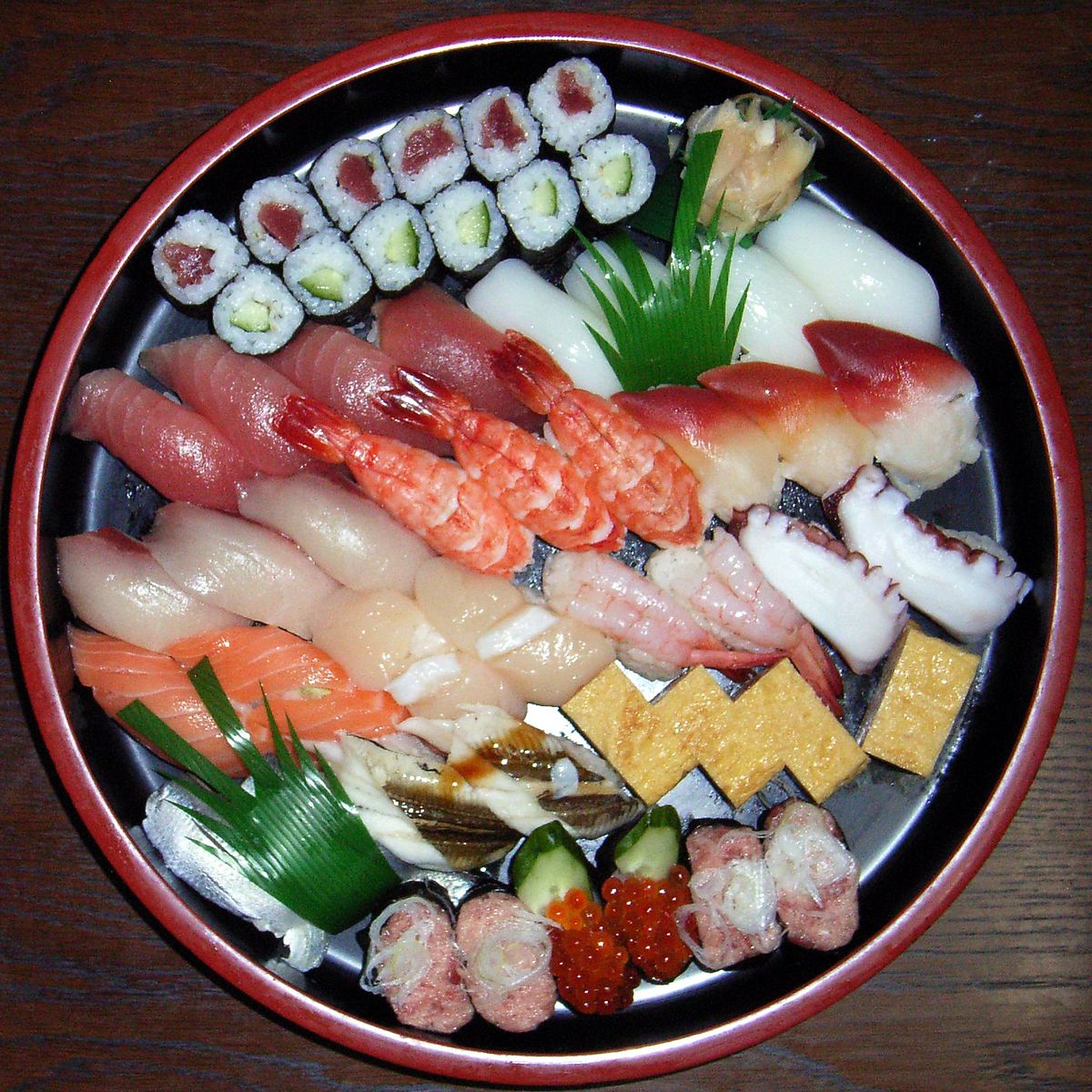
I strongly
suspect that the first thing the first person to
eat the
first morsel of cooked food said, was “Hey,
guys, come here and taste this!”
 Up
until that moment, about 50,000 years ago, humans
ate their food raw.
Thereafter, cooked food was much preferred, even
held in high esteem because it
required precious fuel with which to build the
fire. Among the elite of Europe
and Asia raw food was eschewed right up until the
20th century—vinegar-treated
sushi only appeared in Japan in the 17th century.
Now, raw food of every kind
has gone from a fad to a trend to a ubiquitous
menu item.
Up
until that moment, about 50,000 years ago, humans
ate their food raw.
Thereafter, cooked food was much preferred, even
held in high esteem because it
required precious fuel with which to build the
fire. Among the elite of Europe
and Asia raw food was eschewed right up until the
20th century—vinegar-treated
sushi only appeared in Japan in the 17th century.
Now, raw food of every kind
has gone from a fad to a trend to a ubiquitous
menu item.
What
kept it from such current acceptance was obvious:
Uncooked
food— potentially
full of
bacteria—carries with it a certain danger, and its
nudity on the plate is not
without its sexual connotations. (Eating from the
naked body of a woman is a Japanese quirk called nyotaimori.)
On the other hand, raw food has a certain Zen
purity that gets to the essence of food.
These days raw food seems associated with
slim people for whom the
ingestion of cooked meat is totally un-cool, and
you’re far more likely to read
about people with names like Taylor, Kim, Charlize
and Amber dining at sushi
restaurants than steakhouses.
These days it’s difficult to find a hip new
restaurant that isn’t
doing some version of raw food,
whether it’s an array of ceviches at a Latino
place, a tartare of tuna at a
steakhouse or fresh, barely seared foie gras at a
French restaurant.
Japanese restaurants
serve sushi and
Italian restaurants serve carpaccios.
Not very long ago the only raw items any
American menu dared list were
caviar, 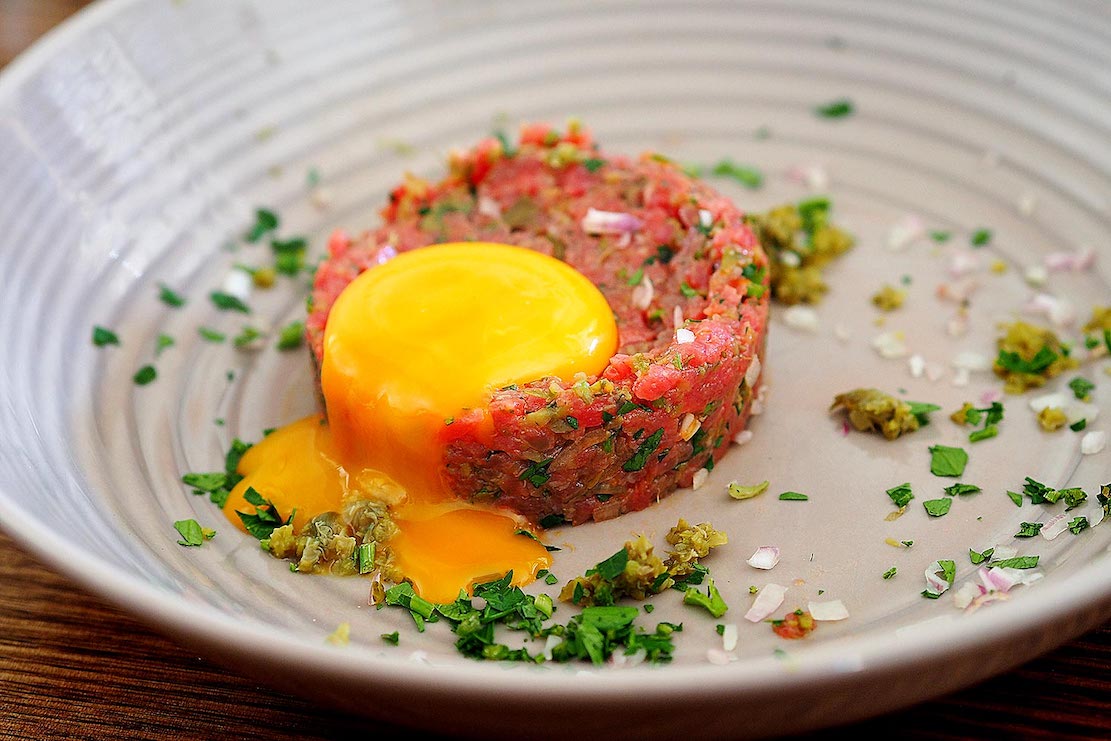 clams,
oysters, and steak tartare with a raw egg on top,
once a
requisite excess at high-end restaurants where
martinis outnumbered wineglasses
on a table. Steak
tartare briefly
dropped from menus when the e.coli
bacteria scare drifted into the ground meat
market, although now it’s firmly
back in favor.
clams,
oysters, and steak tartare with a raw egg on top,
once a
requisite excess at high-end restaurants where
martinis outnumbered wineglasses
on a table. Steak
tartare briefly
dropped from menus when the e.coli
bacteria scare drifted into the ground meat
market, although now it’s firmly
back in favor.
Sushi—which in Japan originally referred to
any food kept fresh in
vinegared rice but came to refer most specifically
to seafood—did not make an
appearance in American restaurants until 1957,
when Moto Saito opened Saito
restaurant in Manhattan and gave lessons to queasy
customers on how to eat
it. There
wasn’t much appetite for it
until well into the 1970s, when sushi bars began
to proliferate in the U.S. at
a time when many more Asian immigrants arrived
here. Yet,
despite a lot of hype about the “art of
sushi making,” it was basically just sliced fish
and vinegared rice.
 It
took twenty years before chef Nobu Matsuhisa at
his Matsuhisa
restaurant in Beverly Hills and Nobu in New York
really revolutionized the
genre by adding spices, chile pepper condiments,
and other ingredients to sushi
he calls tiradito—ideas he picked up when he
worked in Peru, which has a
substantial Japanese population. The
celebrity clientele and, in Nobu’s case, celebrity
ownership that included
Robert DeNiro (left), didn’t hurt sales, so
that those original restaurants, as well
as branches in London, Aspen, Las Vegas and Asia,
are among the hottest tickets
in town, despite—or maybe because of—their being
unbelievably expensive. One
can easily spend $100 per person at Nobu, feasting
on dishes like “New Style
sashimi” of Atlantic salmon spiced with garlic,
ginger, sesame seeds, citron,
and olive oil.
One can just as readily spend
ten times that amount at New York’s Masa for a
twenty-course array of sushi.
It
took twenty years before chef Nobu Matsuhisa at
his Matsuhisa
restaurant in Beverly Hills and Nobu in New York
really revolutionized the
genre by adding spices, chile pepper condiments,
and other ingredients to sushi
he calls tiradito—ideas he picked up when he
worked in Peru, which has a
substantial Japanese population. The
celebrity clientele and, in Nobu’s case, celebrity
ownership that included
Robert DeNiro (left), didn’t hurt sales, so
that those original restaurants, as well
as branches in London, Aspen, Las Vegas and Asia,
are among the hottest tickets
in town, despite—or maybe because of—their being
unbelievably expensive. One
can easily spend $100 per person at Nobu, feasting
on dishes like “New Style
sashimi” of Atlantic salmon spiced with garlic,
ginger, sesame seeds, citron,
and olive oil.
One can just as readily spend
ten times that amount at New York’s Masa for a
twenty-course array of sushi.
Uncooked seafood like sea urchins, in
addition to the more usual clams
and oysters, have been making their way onto
menus, usually in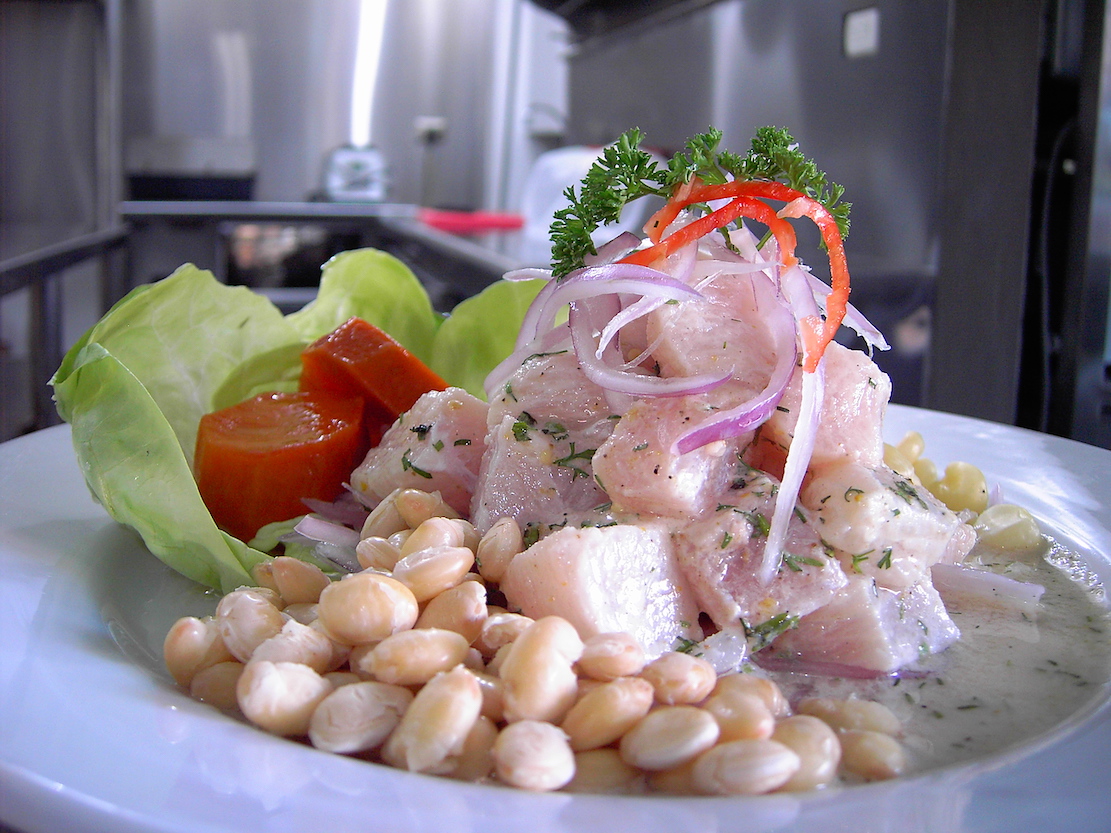 the form of
ceviche (also spelled seviche and escabeche),
which begins with an acidic
marinade of citrus or vinegar and other spices.
(Salt or sugar is what cures
grävlax.) The acid is said to “cook” the seafood,
but I wouldn’t be too
sure. As
with the application of heat,
citric acid does break down the proteins, but it
is far from really being
cooked through. Which, of course, is the point.
the form of
ceviche (also spelled seviche and escabeche),
which begins with an acidic
marinade of citrus or vinegar and other spices.
(Salt or sugar is what cures
grävlax.) The acid is said to “cook” the seafood,
but I wouldn’t be too
sure. As
with the application of heat,
citric acid does break down the proteins, but it
is far from really being
cooked through. Which, of course, is the point.
I,
among many, am very squeamish about raw shellfish,
even if treated to an acid
bath. Having once gotten severely
ill on an oyster, I shall never tempt fate again
with that bivalve, and I like
my mussels, clams, and lobsters cooked through,
past translucence, as
recommended by the Center for Disease Control. The
fact is, even those state
and federal marine organizations in the business
of promoting shellfish sales
warn that eating raw shellfish can be very
problematic. 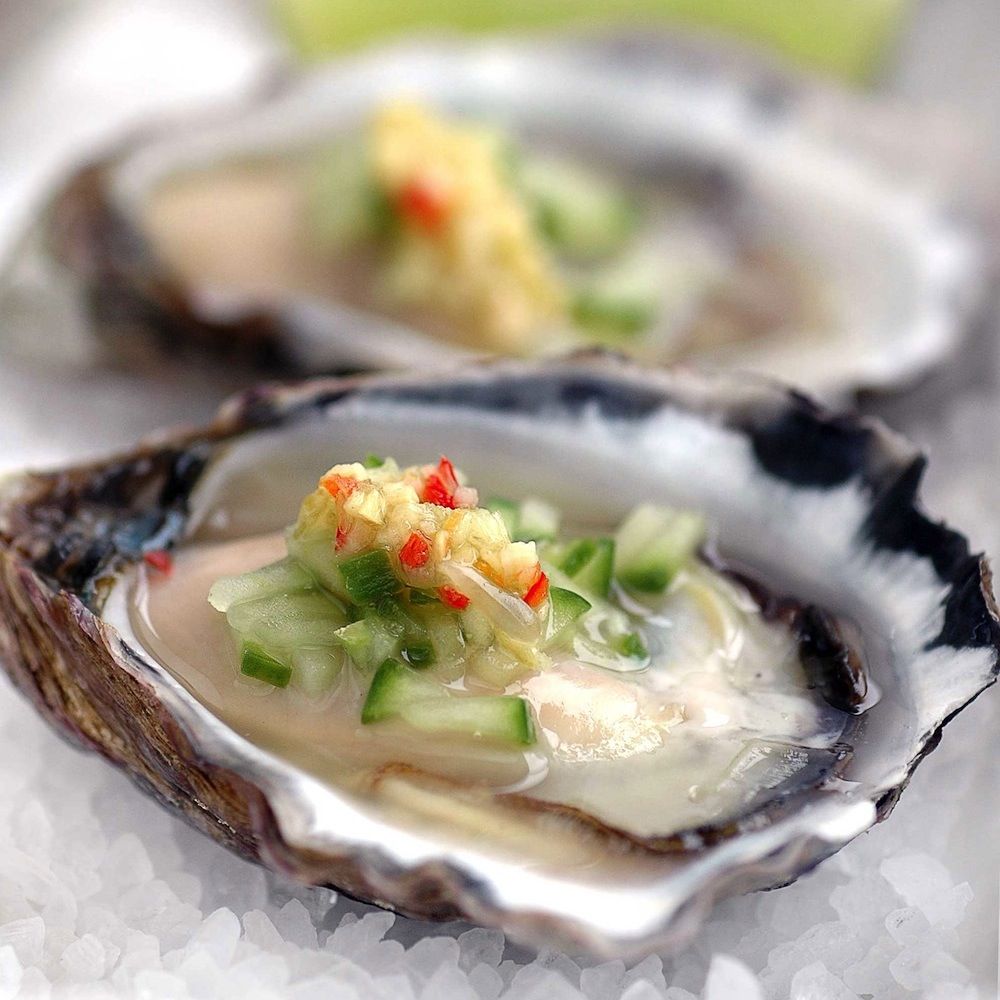 Many are, after all, bottom feeders through
which flows everything on the ocean floor.
Allergic reactions can be mild to
very serious, including anaphylactic shock, while
raw shellfish can also carry
deadly diseases like hepatitis and cholera.
They may also carry worms and parasites.
People with liver disease,
diabetes or cancer should be especially careful. I
only eat raw seafood of any
kind in those restaurants that specialize in them
and that have a high turnover
of product.
Many are, after all, bottom feeders through
which flows everything on the ocean floor.
Allergic reactions can be mild to
very serious, including anaphylactic shock, while
raw shellfish can also carry
deadly diseases like hepatitis and cholera.
They may also carry worms and parasites.
People with liver disease,
diabetes or cancer should be especially careful. I
only eat raw seafood of any
kind in those restaurants that specialize in them
and that have a high turnover
of product.
Nevertheless, millions of people eat
millions of tons of raw seafood
around the world and never suffer any deleterious
effects. What would New
Orleans be without oysters, or Normandy with
mussels?
But
on to a cheerier raw food: Carpaccio, the
mellifluous Italian name
of a Renaissance artist whose work just happened
to be on exhibit in Venice in
1950.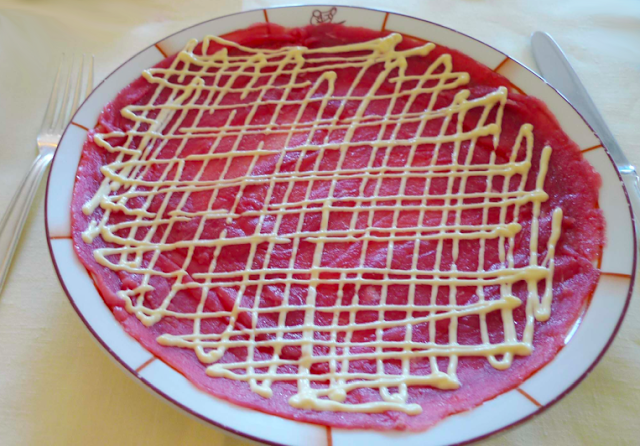 Meanwhile over at the celebrated
Harry’s Bar, owner Giuseppe Cipriani was trying to
please a Countess who
contended her doctor said she could eat only
raw meat. Cipriani thereupon sliced some fine beef
paper thin, dressed it with
a little seasoned mayonnaise and created an
instant classic, which he thereupon
named after Carpaccio, who was known for his use
of reds and whites, which were
mirrored in the dish.
Meanwhile over at the celebrated
Harry’s Bar, owner Giuseppe Cipriani was trying to
please a Countess who
contended her doctor said she could eat only
raw meat. Cipriani thereupon sliced some fine beef
paper thin, dressed it with
a little seasoned mayonnaise and created an
instant classic, which he thereupon
named after Carpaccio, who was known for his use
of reds and whites, which were
mirrored in the dish.
Carpaccio didn’t really catch on in the
U.S. until the 1980s—remember we
already had steak tartare—when it began to appear
on northern Italian menus.
Now there are restaurants doing duck and venison
carpaccio, but I’d draw the
line at chicken, which may contain the salmonella
virus, and wild game. (Note
well: All game—including trout—sold, cooked and
served must by law come from
game farms, whose products are carefully
inspected. In Europe wild game is
allowed to be sold if inspected, as in Scotland,
by an expert; hence, the
seasonal availability of grouse
and
other fowl, which are never eaten raw.)
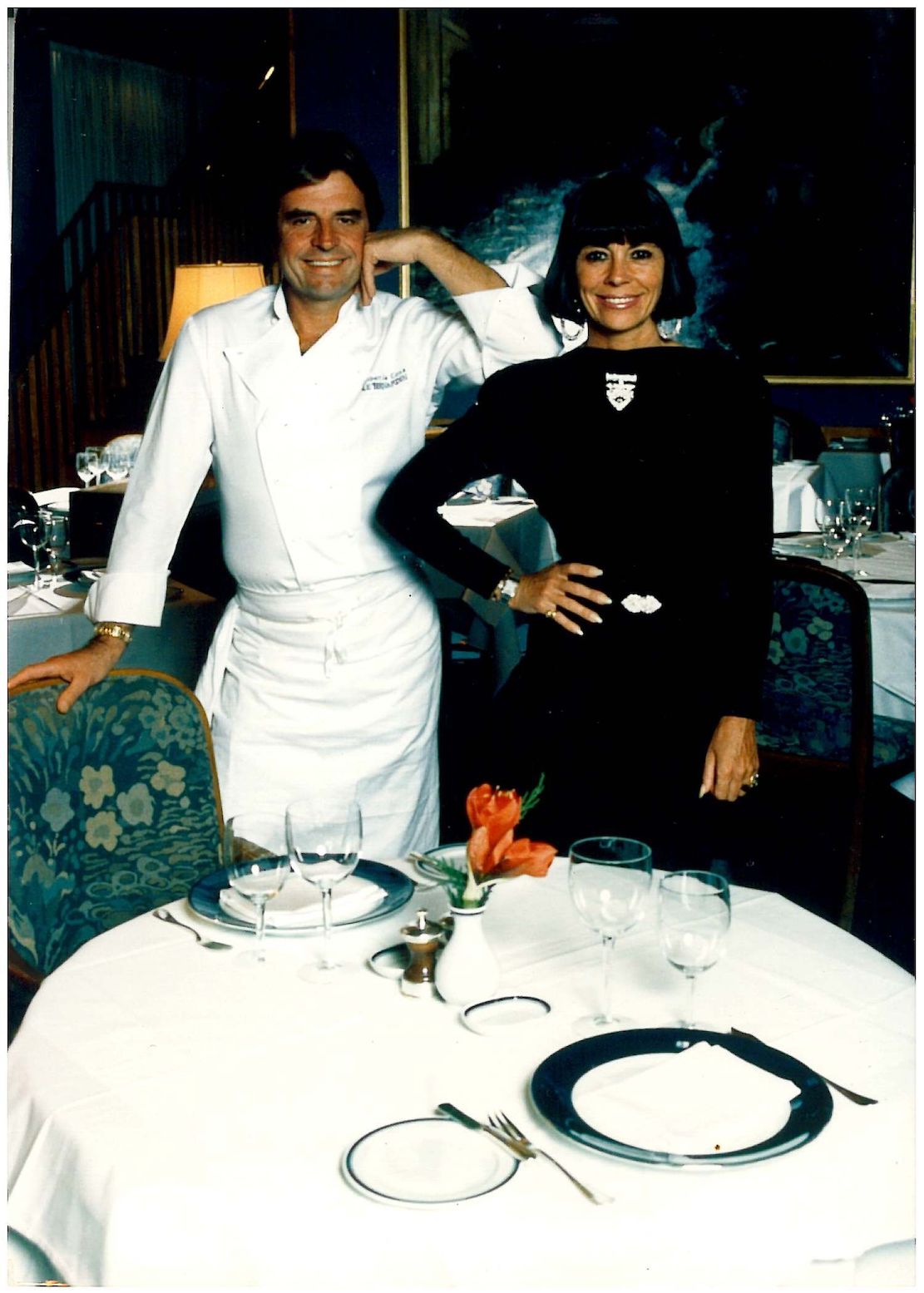 I
love my steaks medium rare and have no problem
eating meat carpaccio,
if, as with seafood, I have confidence in the
restaurant and the chef’s high
standards for ingredients. E. coli
bacteria seems mostly a problem
with commercial ground beef, not with steaks and
roasts, which in a restaurant
would be sliced to order for carpaccio or ground
at the moment for
tartares.
I
love my steaks medium rare and have no problem
eating meat carpaccio,
if, as with seafood, I have confidence in the
restaurant and the chef’s high
standards for ingredients. E. coli
bacteria seems mostly a problem
with commercial ground beef, not with steaks and
roasts, which in a restaurant
would be sliced to order for carpaccio or ground
at the moment for
tartares.
But it was a twist on the idea, and on
Japanese sushi, that made
carpaccio synonymous with any meat
or
seafood fanned out in translucent slices and
drizzled with a light sauce. This was
first accomplished at Le Bernardin
in New York back in the late ‘80s, when the late
chef-owner Gilbert Le Coze
came up with the idea and told his partner, his
sister Maguy (left), what he had in
mind. In The
Le Bernardin Cookbook,
Maguy tells of how Gilbert worked with American
tuna on several dishes, always
unsuccessfully, to his sister’s taste. “Getting it
right wasn’t easy,” she
writes. “After several tasting experiments, I told
Gilbert the tuna was so bad,
it would be better raw. And that is how tuna
carpaccio was born.” From near
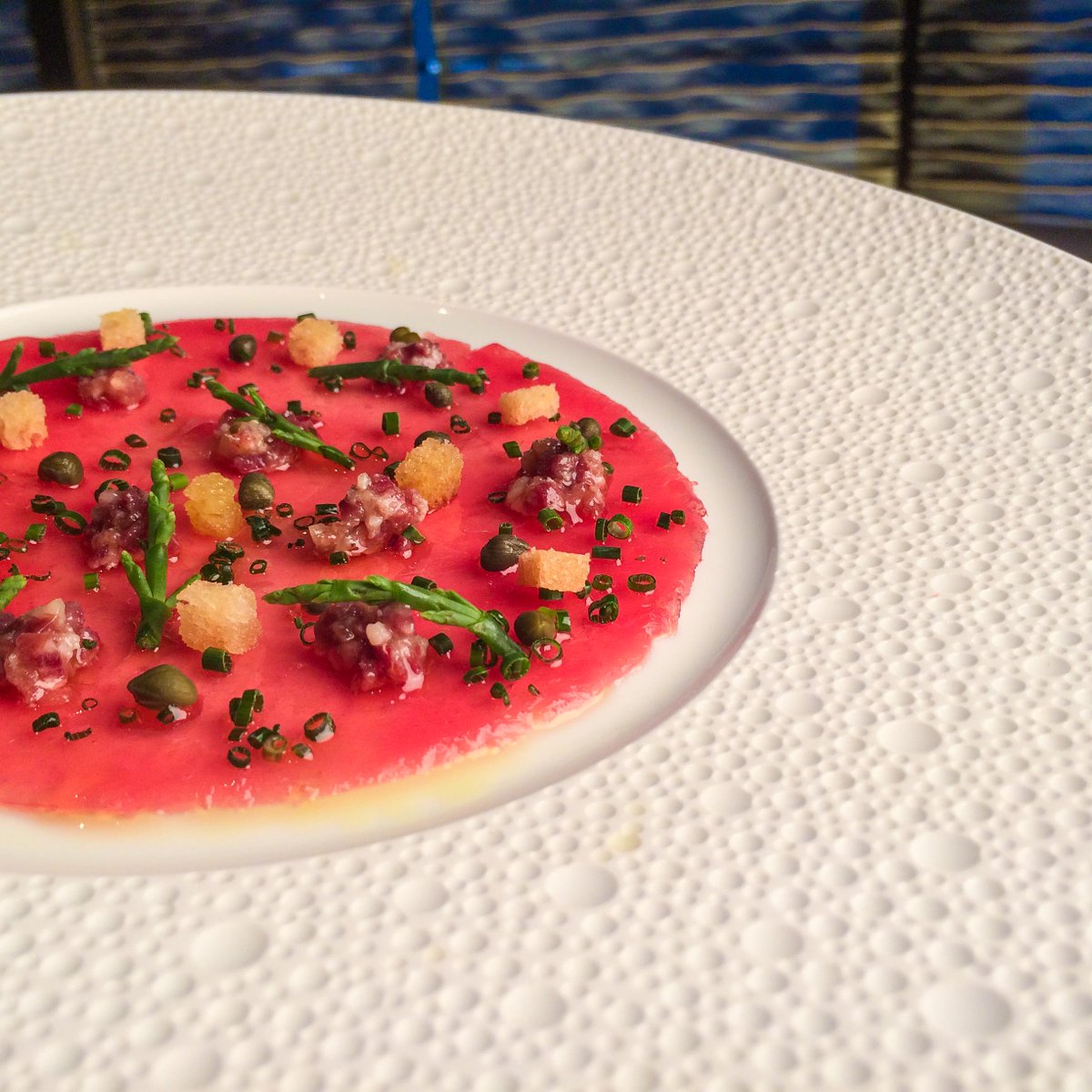 defeat
was victory achieved.
defeat
was victory achieved.
Le Coze
went on to make the dish famous, also using black
bass, halibut
and other unstintingly fresh fish, sometimes
treated to a slightly warm bath of
vinegar, which partakes of the ceviche idea.
The fact that Le Bernardin was such a chic
restaurant helped seafood
carpaccio take wing, so that now just about every
trend-setting chef in America
takes a crack at his own version.
Oddly
enough, the one thing raw food does
not contribute to gustatory pleasure is aroma,
unless the thing has gone bad.
I’ve had too many fishy-smelling ceviches
that have been hanging around too long in a soupy
marinade. But
when it’s good, it’s blissful. The
subtlety of flavor in Le Bernardin’s carpaccios,
the bite of the wasabi against
the coolness of sushi and sashimi, and the
delightful spark of the citrus in a
good, fresh ceviche are among the great
gastronomic experiences in the world.
❖❖❖
By John Mariani
Since, for the time being, I am unable to write about or review New York City restaurants, I have decided instead to print a serialized version of my (unpublished) novel Love and Pizza, which takes place in New York and Italy and involves a young, beautiful Bronx woman named Nicola Santini from an Italian family impassioned about food. As the story goes on, Nicola, who is a student at Columbia University, struggles to maintain her roots while seeing a future that could lead her far from them—a future that involves a career and a love affair that would change her life forever. So, while New York’s restaurants remain closed, I will run a chapter of the Love and Pizza each week until the crisis is over. Afterwards I shall be offering the entire book digitally. I hope you like the idea and even more that you will love Nicola, her family and her friends. I’d love to know what you think. Contact me at loveandpizza123@gmail.com
—John Mariani
To read previous chapters go to archive (beginning with March 29, 2020, issue.
LOVE AND PIZZA
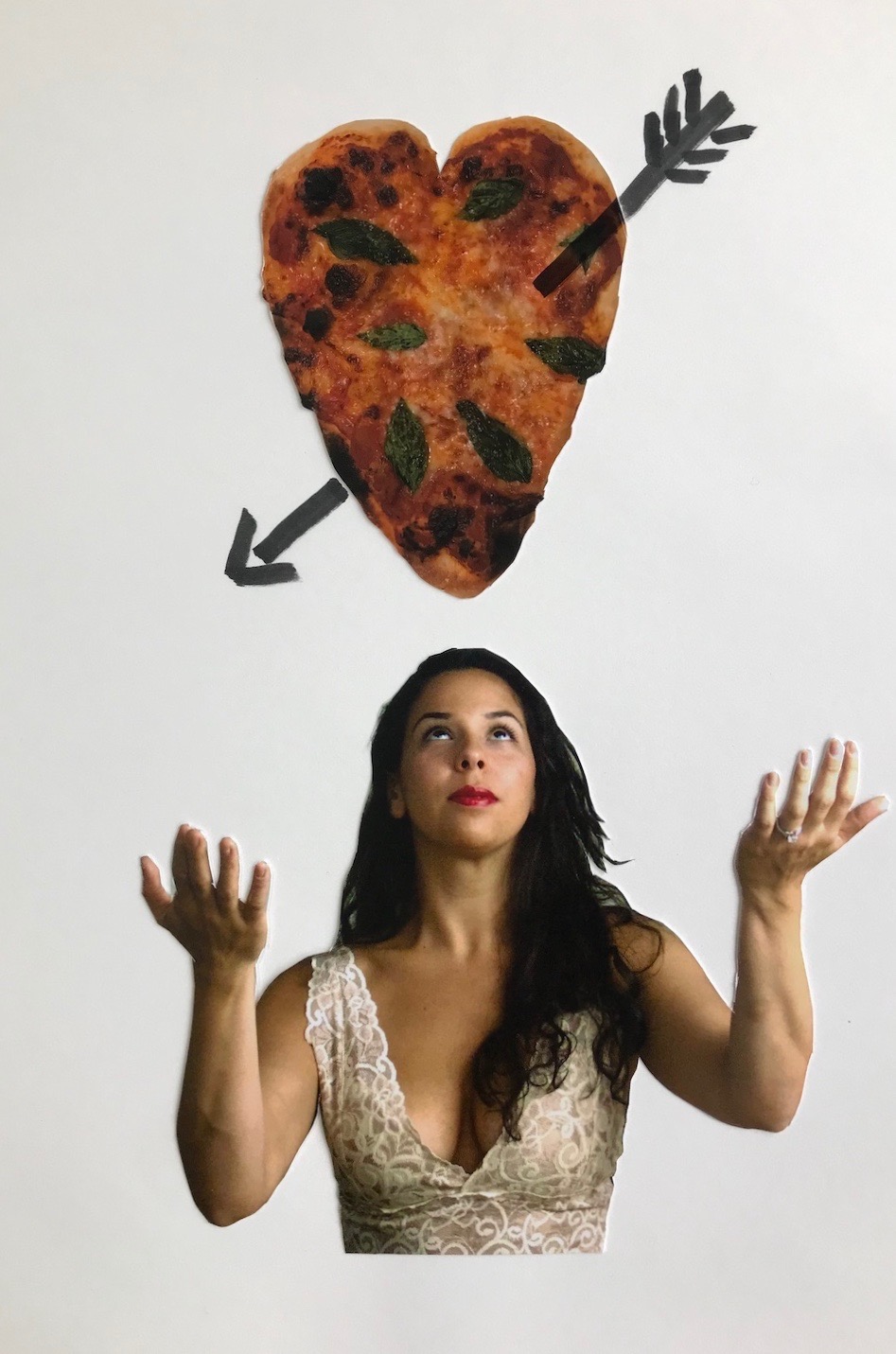
Cover Art By Galina Dargery
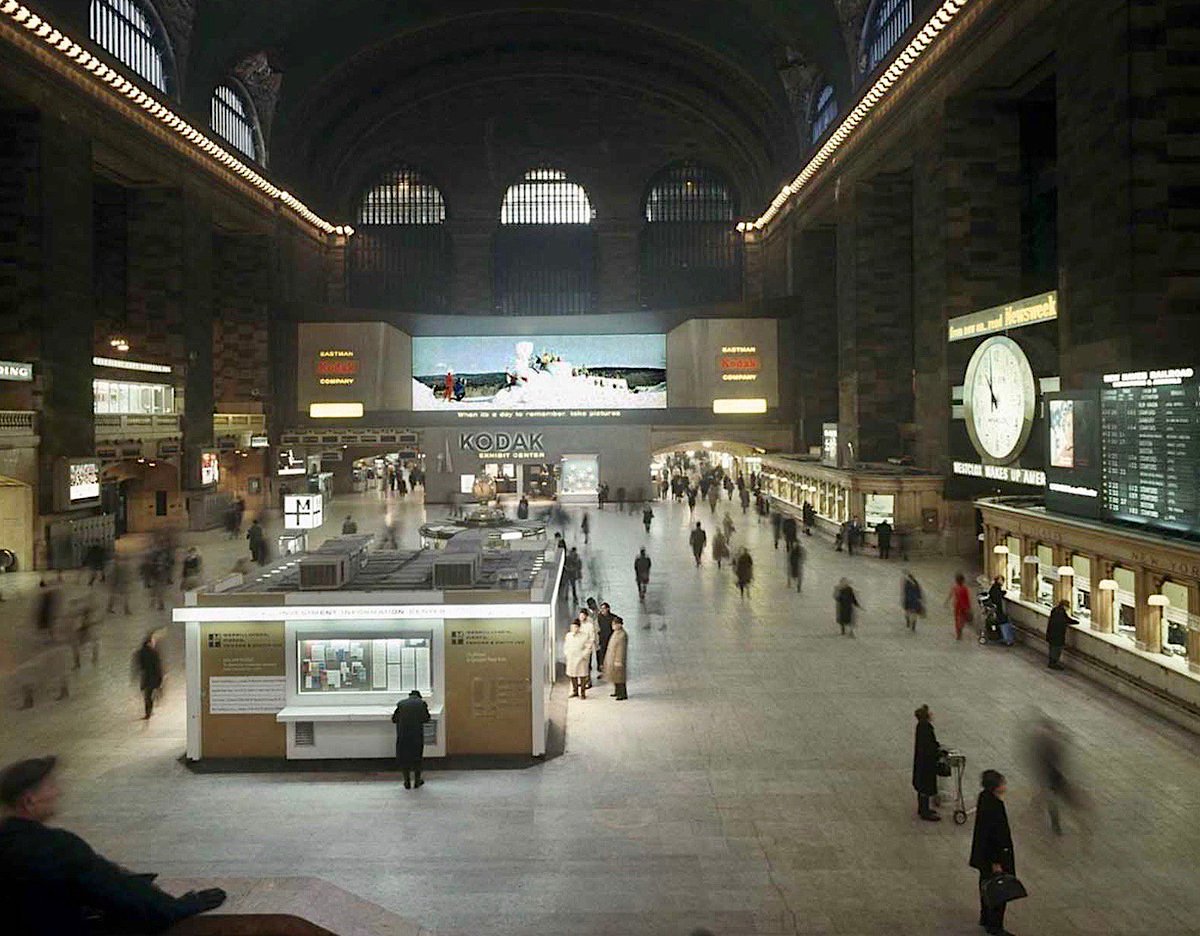
Grand Central Terminal 1985
Nicola
spent the next hour and a half nursing a
cappuccino and croissant—neither of which
tasted anything like those in Milan—and
staring up at the Beaux Arts
architecture of Grand Central Terminal, its
ceiling an expansive mural of the
star-crossed sky with its astrological signs.
Like the old train stations in
Italy, Grand Central was in dreadful shape,
its marble cracked, dirty and
without sheen, its ceiling darkened by smoke,
its once magnificent Tiffany
glass without luster. Whole
skylights
were still covered by material put up during
World War II to block out light
from any possible air raids. A huge modern
clock obscured the sculptured
details on one wall, a wide Kodak ad another.
The waiting room was drearier still, with
benches where
homeless people and college students waiting
for a train slept, left alone by
the transit police.
But there was beauty beneath the grime,
and Nicola saw it for what it
was. More
and more was she thinking that
it was her destiny—if that were not too grand a
word—to restore the tarnished
old world to grandeur, whether it was a mural by
Leonardo da Vinci or a train
terminal in Manhattan. So
much had been
compromised, so much obliterated, even more
destroyed.
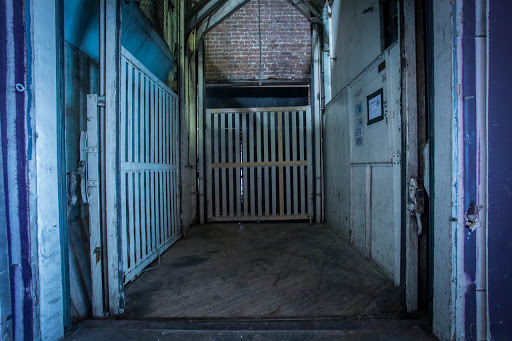 Nicola
looked for the twentieth time at the huge
lighted clock on the
east wall and saw that it was time to take the
subway down to the magazine’s
office in SoHo, two miles from those of the
Condé Nast and Hearst fashion
magazines like Vogue,
Mademoiselle,
Glamour and Harper’s
Bazaar located in midtown
skyscrapers.
SoHo had, by 1985, gone
from a derelict neighborhood to prime territory
for artists and galleries,
offering relatively inexpensive lofts in
historic, landmarked cast-iron
buildings.
Willi magazine was on the fifth
floor of such a structure, which
still retained an ancient freight elevator as
its principal means of ascent.
Nicola
looked for the twentieth time at the huge
lighted clock on the
east wall and saw that it was time to take the
subway down to the magazine’s
office in SoHo, two miles from those of the
Condé Nast and Hearst fashion
magazines like Vogue,
Mademoiselle,
Glamour and Harper’s
Bazaar located in midtown
skyscrapers.
SoHo had, by 1985, gone
from a derelict neighborhood to prime territory
for artists and galleries,
offering relatively inexpensive lofts in
historic, landmarked cast-iron
buildings.
Willi magazine was on the fifth
floor of such a structure, which
still retained an ancient freight elevator as
its principal means of ascent.
Nicola entered the building, where an
all-around
maintenance-receptionist-elevator operator
called upstairs to announce her
arrival, then pulled down an apparatus that
separated the large elevator doors,
yanked the gate to the side and invited Nicola
in. The
doors closed, the man hit a button with a
loud, piercing buzz and the room-like elevator
rumbled upwards, opening onto a
door-less newsroom-like floor, with desks
arranged in some incomprehensible
order, all with IBM electric typewriters and
orange phones. Some staff members
wandered from desk to desk with reams of
newsprint paper over their arms.
There was no receptionist, so Nicola just
went up to the first desk and
said she had an appointment with Elena Duran.
The young woman at the desk, not
even asking Nicola’s name, waved to the rear of
the loft room and said, “Well,
her desk’s over there in the corner, but I’m not
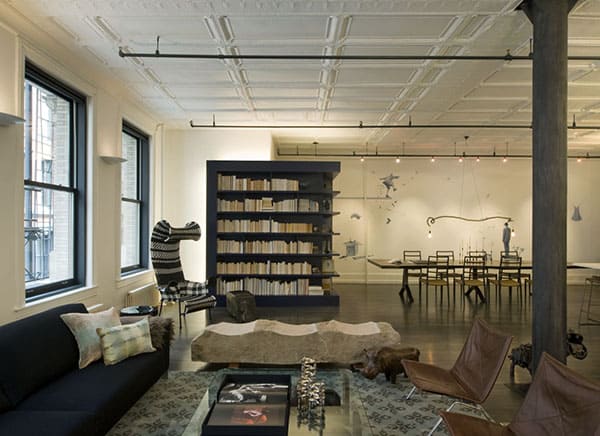 sure if
she’s back there.”
sure if
she’s back there.”
Nicola said thanks and walked the long
room towards the general location
the young woman had waved at, reaching a desk
beneath an expanse of windows
below a soffit on which were stenciled the
words, “Fashion
is a form of ugliness so intolerable that we
have to alter it every six months—Oscar
Wilde.” That
told Nicola something,
though she wasn’t quite sure what it was.
Suddenly from across
the
way, she heard, “Nikki!
Oh, I’m so
glad you’re here!” It was
Elena Duran, in blue jeans, oversized
white blouse and paisley foulard scarf tied
around her neck into a European
knot. “My God,” she continued, “You look more
gorgeous than your photos. How
was your flight? You get some
sleep? Want
coffee?”
Elena had a way of asking
far more questions than she was actually
interested in having answered, so
Nicola just responded, “I’m good.” (She'd
already sent over her clothing measurements.)
“Well, you look fabulous. I
can't wait
for you to meet Diana, our makeup artist and
our stylist Banks.” Then,
shouting to anyone who could hear her
in the echoing room, “Anybody see Diana and
Banks?” Someone
motioned they were in the art
director’s studio, partly sectioned off by
Sheetrock from the rest of the open
room.
“Here,” Elena continued,
“grab a chair, if you can find one in this mess. Sit
down, sit down. So. Here you are. I have
so much to tell you.
“First, let me fill you in
on what we’re trying to do with this magazine.
You know we call it Willi,
which is kind of uni-sex for a good reason: It’s
the first fashion magazine
that is aimed at both women and
men. Not
like Vogue and Bazaar,
which
are for women only, or GQ and
Esquire,
which are for men, straight and
gay. We
are going to try to prove that
by putting both sexes on the same fashion pages
we create an enticing
synthesis.
“Yes, I know that putting
men and women together in a fashion lay-out is
not entirely new, but we’re
going to do it with every
lay-out. We
have a woman in a beautiful Armani gown,
the guy is in a gorgeous Armani suit.
She’s lounging around in a bathing suit,
so is he. It’s
like one of those ideas someone should
have thought of a long time ago. But
didn’t. So,
we get two groups—not to
mention the gay readers—to buy the magazine.”
Nicola was struck by the
simple logic.
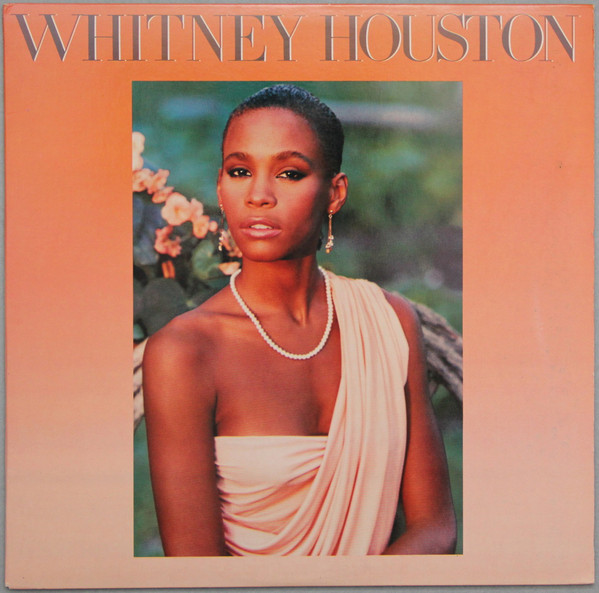 “So,” Elena went on,
“the
other thing is that we skew young, but not too
young because we want readers who can actually
afford to buy good clothes, and
along with those we’ll show plenty of moderately
priced stuff.
And we do it with a brash, in-your-face
edge
and a lot of wit.
Of course we’ll
promote the most creative established
designers—they pay the bills—but I don’t
want to show those haute couture idiots who make
their mannequins look like
they come from Uranus or off a pirate ship; I
mean we’ll show really good
designers like Versace, Armani,
Mugler, Alaia,
Guy Paulin, whose clothes
you can actually wear. We are
not out to
shock but to shake, understand? So we’re beating
the bushes to find
undiscovered new designers—Patrizia Palma when
her collection goes global—and
especially ethnic American kids—Black, Latino,
Japanese, all of them—like the
kids who work for us here. I tell
every
one, get out of this goddamn office and walk
around downtown.
See what the street people are wearing,
which
is always a combination of what they can afford
and facsimiles of what they
can’t.
“So,” Elena went on,
“the
other thing is that we skew young, but not too
young because we want readers who can actually
afford to buy good clothes, and
along with those we’ll show plenty of moderately
priced stuff.
And we do it with a brash, in-your-face
edge
and a lot of wit.
Of course we’ll
promote the most creative established
designers—they pay the bills—but I don’t
want to show those haute couture idiots who make
their mannequins look like
they come from Uranus or off a pirate ship; I
mean we’ll show really good
designers like Versace, Armani,
Mugler, Alaia,
Guy Paulin, whose clothes
you can actually wear. We are
not out to
shock but to shake, understand? So we’re beating
the bushes to find
undiscovered new designers—Patrizia Palma when
her collection goes global—and
especially ethnic American kids—Black, Latino,
Japanese, all of them—like the
kids who work for us here. I tell
every
one, get out of this goddamn office and walk
around downtown.
See what the street people are wearing,
which
is always a combination of what they can afford
and facsimiles of what they
can’t.
“We don’t give a shit what
Cher or Goldie Hawn wears. But Kim Basinger,
Jennifer Beals,
Cyndy Lauper—those are our girls. Have
you heard of
this new black singer—used to be a model—Whitney
Houston, just came out with
her first album?
That’s our girl.
“Guys,
well, that’s tougher: so few showbiz
men know how to dress well. It’s
easy
enough to fall for Johnny Depp or Mel Gibson,
but they don’t give off any real when
it comes to men’s fashion.
Prince is a little out there—did you know he’s
only five-feet-two?—guys are not
going to wear purple high heel boots. Richard
Gere is perfect.
So is Sting and Harrison Ford, Eric
Clapton
and Mick Jagger. See what I mean?”
Nicola just kept nodding.
“Well, that’s Willi
in a nutshell, and I intend you to
be part of it.
So, I am very happy to
tell you, Nikki—by the way, did you think about
the two k’s in your name?—that I want to
do a five-page spread on you, with
different men, plus the cover. Our
first
issue. September. Comes
out in August. Whaddaya think?”
To say
Nicola was
nonplussed was barely to hint at her state of
mind. Grateful
as she already was to Elena, Nicola
had no idea how much the editor intended to put
on her un-tried shoulders. Nicola
Santini stammered, “Give me time to
digest this.”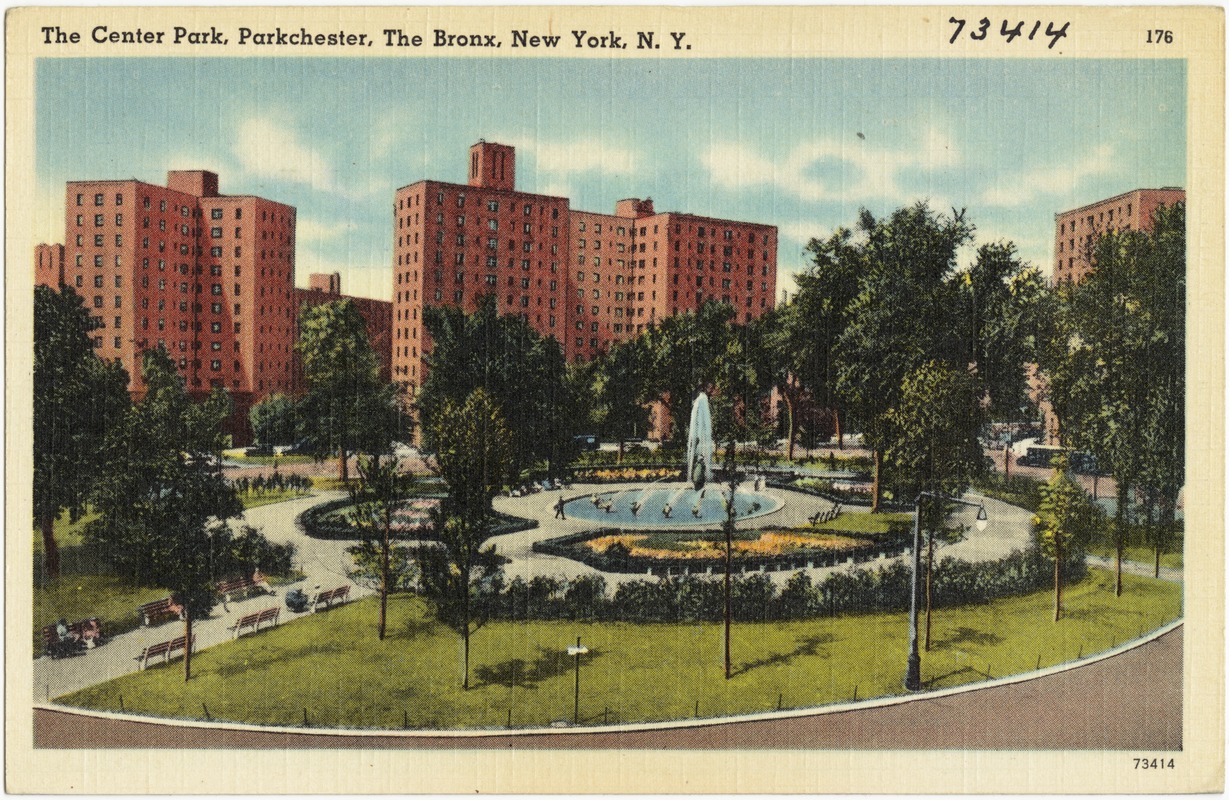
“And this part, you’re really
going to love,” said Elena. “I saw in the Herald
Tribune that crazy woman wrote about you
as the girl from `Duh Bronx.’
Well, you probably don't know it but I, too,
am a Bronx girl.
My parents are from
Puerto Rico and I grew up in Parkchester, not
too far from where you live up in
Belmont, right?
Believe me, it was not
easy making my way in the fashion
business as a Latina, even if I didn't have an
accent. Started as a secretary,
worked my way up, wrote stories for Cosmopolitan
en Español and People en
Español, then some of the
Condé Nast titles, and here I am.
“Anyway, for the debut
issue now I want to exploit the hell out of the
Bronx! You
do know that Ralph Lifshitz is from the
Bronx?”
Nicola knit her brow and
said, “Ralph who?”
“Oh, he changed his name
to Ralph Lauren when he was sixteen.”
“You’re kidding.”
“Nope. Also, although he
never changed his name, Calvin Klein is a nice
Bronx Jewish boy, too. So’s his
business partner, Barry Schwartz.”
“I had no idea.”
“Of course, their designs
aren’t particularly edgy. Ralph
always
wanted to believe he was born on a Palm Beach
estate next to the Kennedys and
grew up playing polo with Gary Cooper.
But what I’m looking for are the young
designers in New York, Europe and
Asia who have street cred and who design around
what they are and where they
came from.”
Nicola’s head was
swimming, quite happily. “This is all amazing to
me. I
mean I knew about Bronx people like Tony
Curtis and Peter Falk and
Billy Joel,
but. . . .”
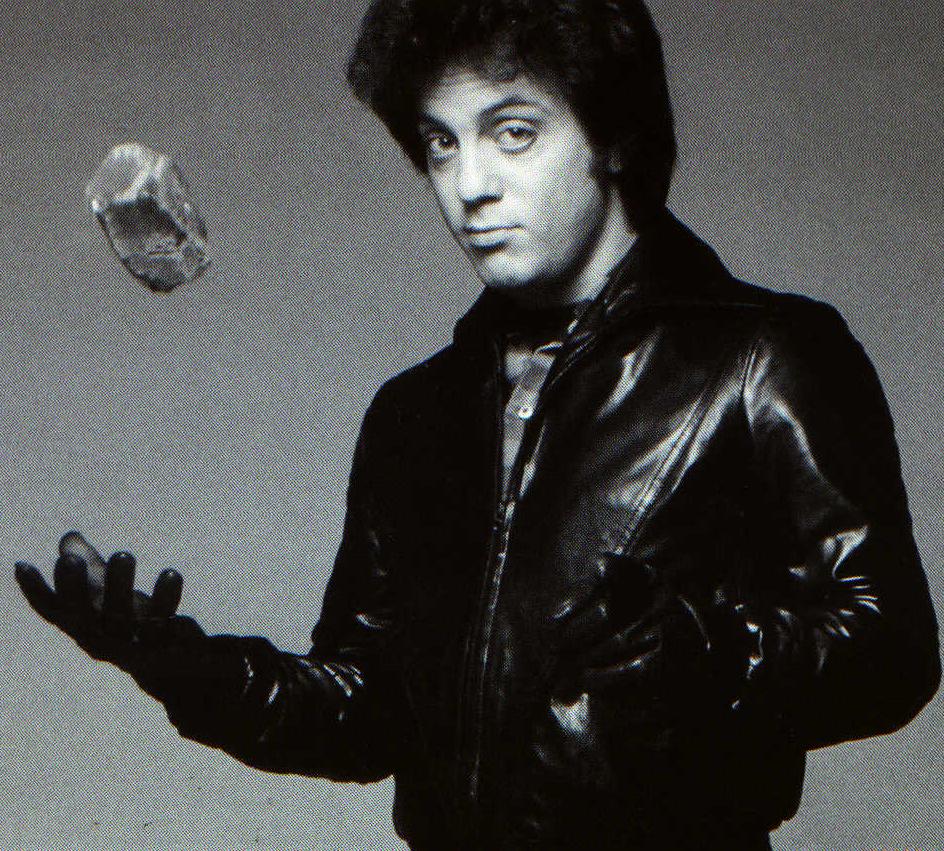 “Hm. I
wonder how Billy
Joel dresses,” Elena said.
“Hm. I
wonder how Billy
Joel dresses,” Elena said.
“Okay, so here’s what
we’re doing for the next four or five days.
We are going to shoot you in five
different Bronx locations—some
familiar, some not—if possible, with a guy who’s
associated with the
place. You’ll
be wearing a Bronx
designer’s clothes, and it’s going to be
fabulous! You
agree?”
Nicola was speechless but
finally managed to answer, “Even aside from my
being a tiny part of it all,
this is an incredible idea!”
“I knew you’d like it,
Nikki. So, let's get to work.”
Elena stood up and
shouted across the room,
“People! Listen
up!
I want you all to meet our new cover
model—and she is going to be very
big!—Nikki Santini, a nice Bronx girl like me.
And I want every one of you to
think how we can capitalize on her undoubted
success with Willi.”
The staff at other fashion
magazines were dutifully reserved and cynical
about anything anyone else
considered novel, but the young hirees at Willi
roared out their approval, applauding,
whistling and shouting, “Yo, Nikki!”
When things quieted down,
Elena pointed to the soffit above her head and
said to Nicola, “You see those
words up there? Sounds snarky, right? Well,
that is our philosophy. Fashion
can
indeed be ugly—but it can be really, really cool
for a while—and that’s why it has to
be changed every six months. That
is what we intend to do. Every month! Well,
every two months. We can only
afford to come out six times a year for now.”
From there Nicola was
ushered into the art studio to meet Diana and
Banks, who welcomed her
warmly. Diana,
a woman about
thirty-five,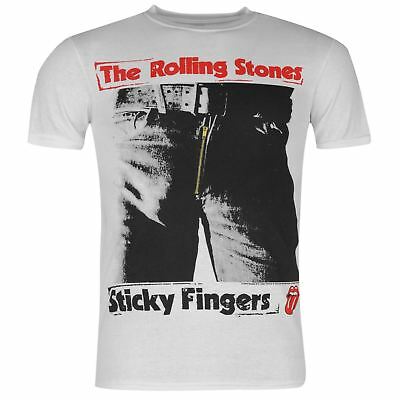 with a pixie haircut
and wearing jeans and a Sticky Fingers
t-shirt, looked at Nicola and said, “I saw
pictures of you from Milan. You
really
can look like Claudia Cardinale.”
Banks, who had spiky hair frosted at the
top, was in rolled up jeans and
sneakers, with a white t-shirt and short
toreador jacket.
with a pixie haircut
and wearing jeans and a Sticky Fingers
t-shirt, looked at Nicola and said, “I saw
pictures of you from Milan. You
really
can look like Claudia Cardinale.”
Banks, who had spiky hair frosted at the
top, was in rolled up jeans and
sneakers, with a white t-shirt and short
toreador jacket.
“Hi, Nikki—okay if I call
you Nikki?—we are going to have a buh-last! Wait
till you see the clothes we have planned
for you.”
With that, a benevolent
assault began, the three professionals, joined
by a few others at various
points, assessing every inch of Nicola’s
anatomy—“This hair is fabulous!” “Her
figure will work for the clothes.” “Her lips are
killers.”
Then Elena clapped her
hands and said, “Okay, people, let’s head up to
the Bronx. The photographer is
already there.”
“Who are we using?” asked
Banks.
“A new guy, from Brazil,
Hector Saint-Nazaire.”
“Oh, I know his work from WWD.
He’s fabulous!”
With that,
assistants
packed up the last items of clothing and
accessories they would need for the
day’s shoot, and six of the staff, along with
Nicola, filled the freight
elevator. Downstairs
were three vans.
After a few minutes double-checking that
all
was loaded, the entourage left SoHo, headed
across Houston Street, got on the
FDR Drive, then headed up the Deegan Expressway,
to north of Yankee Stadium in
the West Bronx, and exited, following directions
to Sedgwick Avenue.
© John Mariani, 2020
AN INTERVIEW WITH GUT HERMANNSBERG
By John Mariani
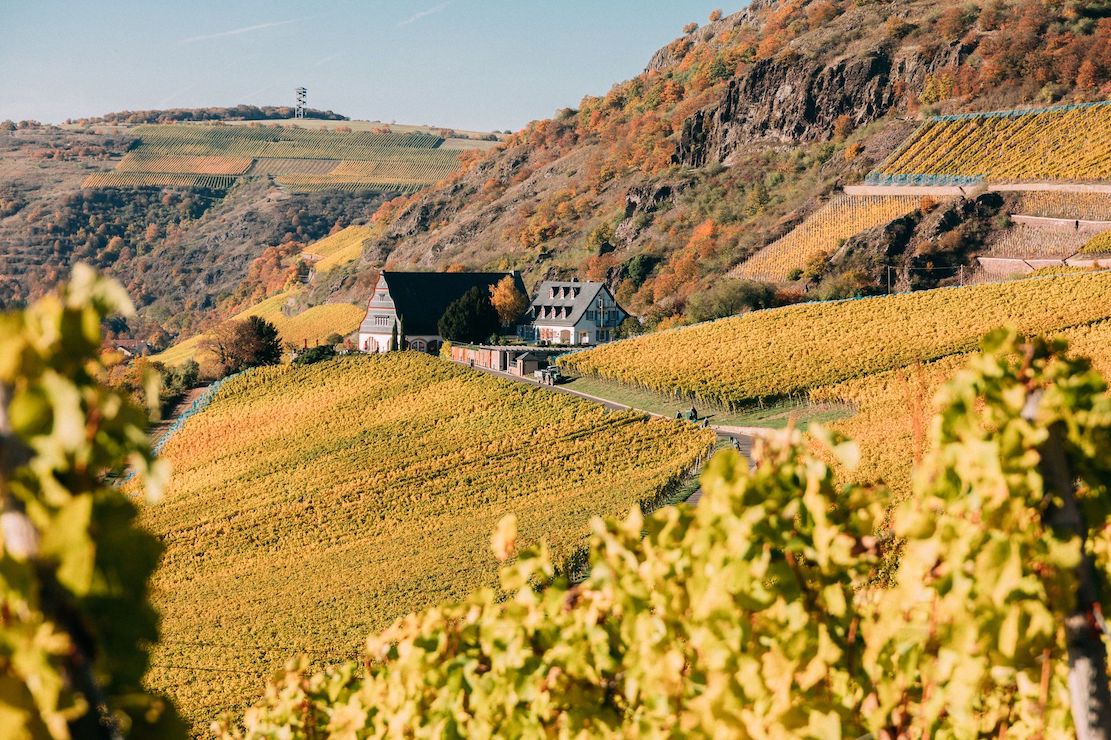
The respect for great German Rieslings has long been higher than sales of this classic varietal. Once, such wines were distinguished by their degree of sweetness, but the worldwide preference for dry wines blunted the appeal of German Rieslings, whose producers re-formulated many of their wines to be “trocken,” dry in an attempt to win back wine drinkers. Germany still makes superb sweet wines, but the future of Rieslings is in the hands of German’s young winemakers at small estates like Gut Hermannsberg in the Nahe region. The winery dates back to 1902 as a Royal Prussian Domaine, but today winemaker Kasten Peter makes dry Rieslings, noting, “Dogmatism isn't our thing.” I interviewed the winery’s CEO Achin Kirchner (left) about the current state of Rieslings.
 1.What
is there are about your Rieslings
that make five years of aging ideal?
1.What
is there are about your Rieslings
that make five years of aging ideal?
We
now release our top dry Rieslings from the
legendary Kupfergrube vineyard site
as a GG Reserve five years after the harvest. The
decision to switch from
release at two years of age to five was based on
our experience with earlier
vintages. We are convinced that great wines must
be vinified very cautiously
and without any haste, gently guiding the natural
processes. At Gut
Hermannsberg this means long skin-contact of the
grapes to extract aromas,
minerals and tannins from the skins in a similar
way to red winemaking, but
before the alcoholic fermentation starts. We need
the tannins to harmonize the
pronounced acidity typical for our seven terroirs
(GG, or “Grand Cru” sites). The
same is true of the wines’ long aging on the lees
in cask, which for the GGs
lasts between one to two years. All the wines from
our 30 hectares (74 acres)
of vineyards are wild fermented and we don’t fine
them, preferring to let time
deal with potential instability problems in the
natural way.
Whenever we do a vertical
tasting of the GGs from the Kupfergrube
or the Hermannsberg sites (the latter is a
monopoly site of Gut Hermannsberg),
then we always come to the same conclusion: The
older the wines are the better
they taste. Five years is really only just the
beginning! When asked, we always
recommend more aging than that. How much? We’re
cautious, but don’t want to
underestimate their aging potential. Recently we
tasted a 1949 Kupfergrube with
a group of journalists and top sommeliers. They
all agreed that it tasted
unbelievably fresh and complex.
The principal of giving great
Riesling wines long aging before
release was normal in Germany into the early1970s.
It was the arrival of modern
cellar technology that abolished this by
accelerating the clarification and
maturation processes. So, we and some other top
German producers are now
returning to that tradition. Perhaps some people
will say that’s old-fashioned,
but we all think it’s simply the best way for 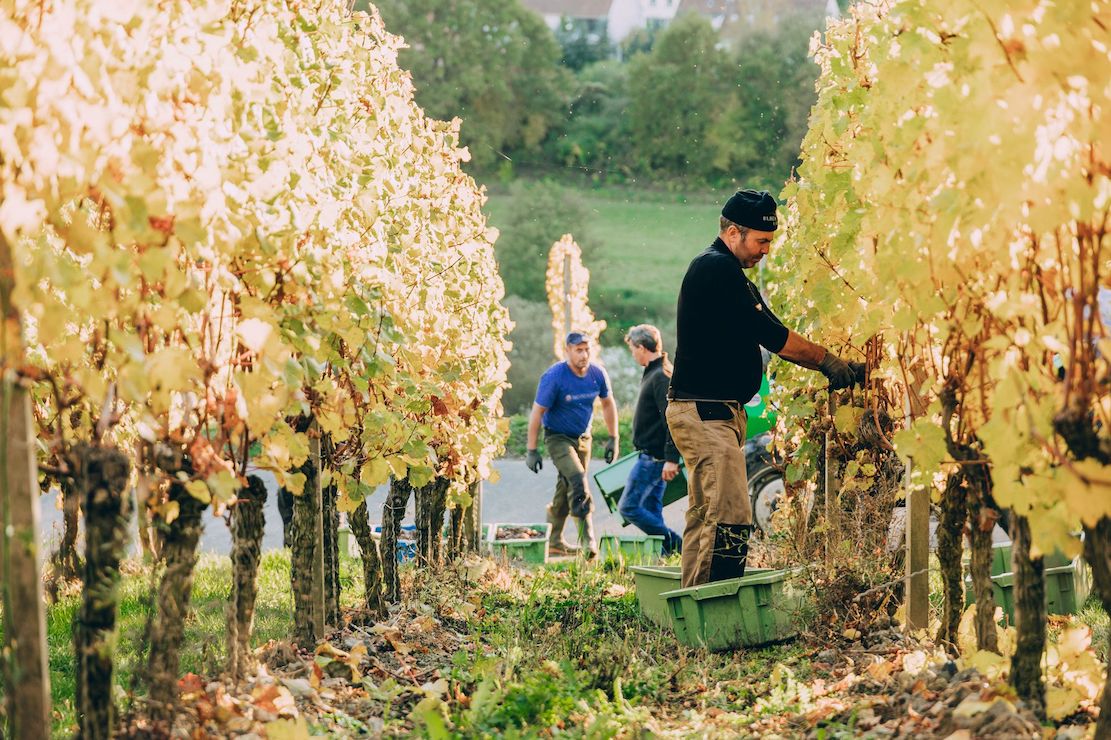 the
quality and character of the
wines.
the
quality and character of the
wines.
2.
As I wrote
last week in a column, most
white wines of the world should be drunk as soon
as you buy them at the store.
Does that mean that when I buy your wines they
are ready to drink and need no
further aging?
For
99% of modern white wines it’s true that they
should be drunk right away, but
great Rieslings belong to the 1% that have as much
aging potential as any reds
on Planet Wine. You can compare our GGs to a
special sauce that a top chef
prepares. He could knock out a tasty sauce quickly
using cheap ingredients, but
to make a really delicious one he must use only
the best ingredients and take
several days.
Easy-drinking wines are
professionally made winemaker-wines, and
they’re ready for consumption from the moment they
go into the bottle. Our
entry-level dry “Just Riesling!” also belongs to
this category. In contrast,
our GGs only develop their full complexity and
harmony through further aging in
bottle. We refer to this potential that slowly
unfurls with time as the Third
Dimension of Wine. The best thing is to put a
number of bottles of one (or
more) of our GGs in the cellar so that you can
enjoy following the wine’s
development over years, or even decades.
3.
Tell me about the “transition phase.”
Every
great wine has its own aging curve. For example,
the 2016 Hermannsberg GG
(delicious now, but with many years ahead of it)
isn’t comparable with the 2018
Hermannsberg GG (only just beginning to go through
its paces, but with decades
of aging potential). The variation in vintage
character in the cool climate
Nahe region is immense! Although our climate
warmed during the last decades,
like everywhere else, climate change hasn’t
altered at all. It can be the case
that certain of our wines are very attractive in
the first year, but then close
up and go through a long transition phase before
awakening to a second life
after five or more years. If you encounter a
three- or four-year old GG from us
and it is a bit closed, then it’s definitely not
finished, rather it needs yet
more aging. Each of our seven terroirs has its own
special character and
personality, so this is a factor too.
6.
On your website you write, "The
Kupfergrube wines have been dividing opinion
since the first vintage in 1910
due to a pungent smoky minerality that many wine
lovers find
electrifying.” Can you explain where this
flavor comes from in the soil?
 The Nahe region is of great
geological complexity with volcanic
soils like the melaphry of the Kupfergrube,
clay-slate as in our Hermannsberg
monopoly site, but also loess, loam and gravel,
for example around Bad
Kreuznach where “Just Riesling!“ grows. This is an
important reason why the
region’s wines are so fascinating. The smoky
minerality of the Kupfergrube
comes from the melaphry soil and this is
underlined by the special microclimate
of the site with its extreme day-night temperature
fluctuations.
The Nahe region is of great
geological complexity with volcanic
soils like the melaphry of the Kupfergrube,
clay-slate as in our Hermannsberg
monopoly site, but also loess, loam and gravel,
for example around Bad
Kreuznach where “Just Riesling!“ grows. This is an
important reason why the
region’s wines are so fascinating. The smoky
minerality of the Kupfergrube
comes from the melaphry soil and this is
underlined by the special microclimate
of the site with its extreme day-night temperature
fluctuations.
Along with the Hermannsberg,
the steep and terraced Kupfergrube is
the most famous of Gut Hermannsberg’s seven
terroirs. When the estate was
founded as a Royal Prussian Wine Domain in 1902
(it’s the Prussian eagle on the
label!) a great many climate and soil tests were
done to find the perfect
location for the new vineyard sites they created.
Back then where the
Kupfergrube stands today there were only volcanic
cliffs, stunted oaks and an
abandoned copper mine (the vineyard name means
copper mine in German). The
interaction between the vines and the soil, also
the microbial life of the
soil, is still being researched, but is extremely
complex. Although we cannot
precisely explain it, experience teaches us that
the Kupfergrube always has
this special character and enormous aging
potential.
7.
What is the Verband deutscher
Prädikatsweingüter (VDP)?
The
VDP is an association of around 200 of the leading
German wine estates founded
a little over a century ago. They are the elite of
the roughly 15,000 wine
producers in Germany and membership is a kind of
estate classification. Strict
rules must be followed in order to put the VDPs
eagle symbol on the label and
capsule of your wines. The VDP’s classification of
the vineyard sites for the
production of dry GGs/ ”Grand Crus” is modeled on
that of Burgundy.
8.
German wines have lagged behind in
sales of wines globally for many years. What do
you believe are people’s
reasons for preferring French, Italian,
California, etc wines?
Germany
is famous for automobiles, engineering and machine
tools: the exact opposite of
wine! Wine is rooted in the soil and the best
producers are nearly all small
companies that combine a great deal of manual work
with low tech. This side of
Germany is still too little-known.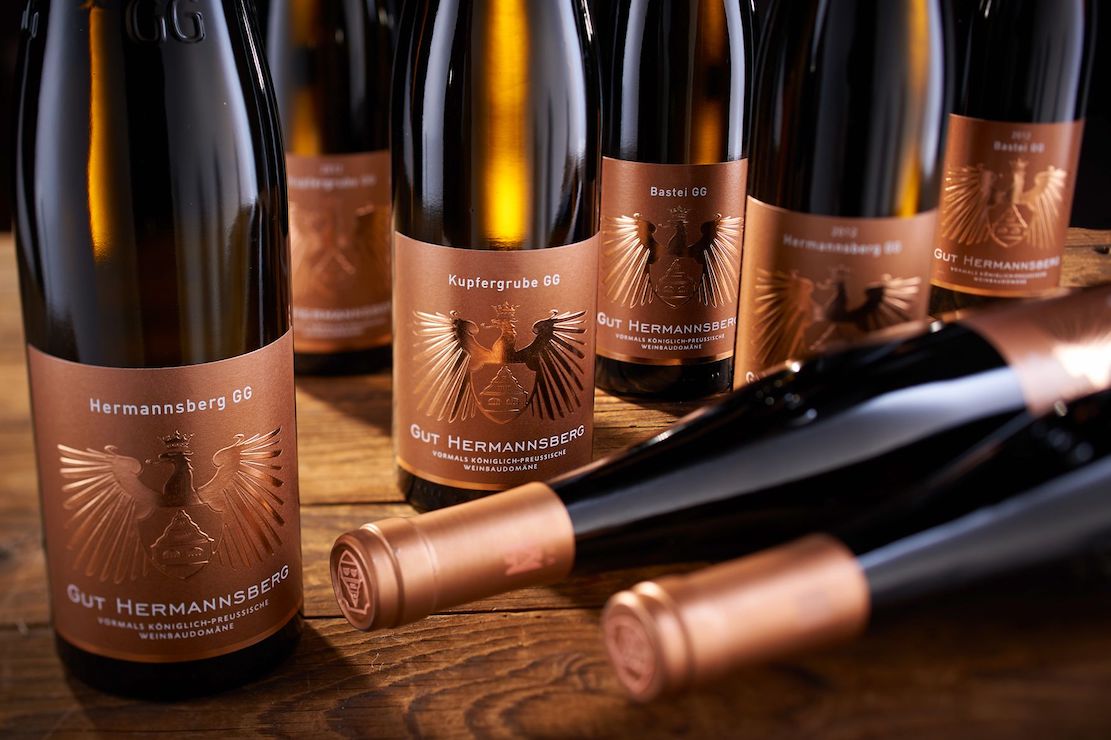
Riesling is the German
grape
and it’s a great ambassador for the nation’s
terroirs. However, many of
these are really small. For example, Gut
Hermannsberg is the largest owner in
the GG sites Kupfergrube and Bastei, but our
holdings in these sites are
respectively 12 hectares (30 acres) and less than
one hectare (two acres). This
situation is incompatible with modern marketing
and branding. In contrast,
Château Mouton Rothschild produces about 250,000
bottles per year, roughly 50
times the annual production of the Kupfergrube GG!
It helps us a lot that many top
sommeliers regard Riesling as one
of the most exciting grape varieties, and these
wines therefore have a firm
place on top restaurant wine lists around the
world. German Riesling isn’t
well-suited to the mass market, not because the
best wines are not only limited
by the size of the best terroirs, but also by the
high production costs in the
steep vineyards.
9.
What is the current state of the sugar
levels in the finest Beerenauslese and
Trockenbeerenauslese?
Nobly
sweet BA (Beerenauslese) and TBA
(Trockenbeerenauslese) made from shriveled
botrytis-affected grapes are a very
special niche not only for Germany. It’s a
wonderful tradition, but at Gut
Hermannsberg we only produce them in ideal years,
like 2015 and 2019. The sugar
content can be as much as 300 grams per liter
(30%), but it matches the
enormous aromatic concentration and structure of
these wines that are made for
eternity. We recently auctioned a bottle of the
1921 TBA from the Kupfergrube
for almost 15,000 Euros! The total production of
the 2015 TBA from the
Kupfergrube was just 20 liters, because the grapes
were so shriveled and the
selection was so time-consuming. The wine was
rated 100 points by Robert
Parker’s The
Wine Advocate. However,
we are most famous for the dry wines from our
seven terroirs and they account
for 90% of our production.
10.
Describe what makes the Nahe
region different from others in Germany.
In
spite of climate change, we are still able to
produce elegant and precise
Rieslings with fine aromas and intense minerality,
meaning wines with a
pronounced cool climate character. The complex
interplay of our stony soils and
the special climate of the region is really
perfect for dry Riesling!
Sponsored by

Any of John Mariani's books below may be ordered from amazon.com.
 The Hound in Heaven
(21st Century Lion Books) is a novella, and
for anyone who loves dogs, Christmas, romance,
inspiration, even the supernatural, I hope you'll find
this to be a treasured favorite. The story
concerns how, after a New England teacher, his wife and
their two daughters adopt a stray puppy found in their
barn in northern Maine, their lives seem full of promise.
But when tragedy strikes, their wonderful dog Lazarus and
the spirit of Christmas are the only things that may bring
his master back from the edge of despair.
The Hound in Heaven
(21st Century Lion Books) is a novella, and
for anyone who loves dogs, Christmas, romance,
inspiration, even the supernatural, I hope you'll find
this to be a treasured favorite. The story
concerns how, after a New England teacher, his wife and
their two daughters adopt a stray puppy found in their
barn in northern Maine, their lives seem full of promise.
But when tragedy strikes, their wonderful dog Lazarus and
the spirit of Christmas are the only things that may bring
his master back from the edge of despair. WATCH THE VIDEO!
“What a huge surprise turn this story took! I was completely stunned! I truly enjoyed this book and its message.” – Actress Ali MacGraw
“He had me at Page One. The amount of heart, human insight, soul searching, and deft literary strength that John Mariani pours into this airtight novella is vertigo-inducing. Perhaps ‘wow’ would be the best comment.” – James Dalessandro, author of Bohemian Heart and 1906.
“John Mariani’s Hound in Heaven starts with a well-painted portrayal of an American family, along with the requisite dog. A surprise event flips the action of the novel and captures us for a voyage leading to a hopeful and heart-warming message. A page turning, one sitting read, it’s the perfect antidote for the winter and promotion of holiday celebration.” – Ann Pearlman, author of The Christmas Cookie Club and A Gift for my Sister.
“John Mariani’s concise, achingly beautiful novella pulls a literary rabbit out of a hat – a mash-up of the cosmic and the intimate, the tragic and the heart-warming – a Christmas tale for all ages, and all faiths. Read it to your children, read it to yourself… but read it. Early and often. Highly recommended.” – Jay Bonansinga, New York Times bestselling author of Pinkerton’s War, The Sinking of The Eastland, and The Walking Dead: The Road To Woodbury.
“Amazing things happen when you open your heart to an animal. The Hound in Heaven delivers a powerful story of healing that is forged in the spiritual relationship between a man and his best friend. The book brings a message of hope that can enrich our images of family, love, and loss.” – Dr. Barbara Royal, author of The Royal Treatment.
 |
The Encyclopedia of American Food and Drink by John F. Mariani (Bloomsbury USA, $35) Modesty forbids me to praise my own new book, but let me proudly say that it is an extensive revision of the 4th edition that appeared more than a decade ago, before locavores, molecular cuisine, modernist cuisine, the Food Network and so much more, now included. Word origins have been completely updated, as have per capita consumption and production stats. Most important, for the first time since publication in the 1980s, the book includes more than 100 biographies of Americans who have changed the way we cook, eat and drink -- from Fannie Farmer and Julia Child to Robert Mondavi and Thomas Keller. "This book is amazing! It has entries for everything from `abalone' to `zwieback,' plus more than 500 recipes for classic American dishes and drinks."--Devra First, The Boston Globe. "Much needed in any kitchen library."--Bon Appetit. |
"Eating Italian will never be the same after reading John Mariani's entertaining and savory gastronomical history of the cuisine of Italy and how it won over appetites worldwide. . . . This book is such a tasteful narrative that it will literally make you hungry for Italian food and arouse your appetite for gastronomical history."--Don Oldenburg, USA Today. "Italian
restaurants--some good, some glitzy--far
outnumber their French rivals. Many of
these establishments are zestfully described
in How Italian Food Conquered the World, an
entertaining and fact-filled chronicle by
food-and-wine correspondent John F.
Mariani."--Aram Bakshian Jr., Wall Street
Journal.
"Equal parts
history, sociology, gastronomy, and just
plain fun, How Italian Food Conquered the
World tells the captivating and delicious
story of the (let's face it) everybody's
favorite cuisine with clarity, verve and
more than one surprise."--Colman Andrews,
editorial director of The Daily
Meal.com. "A fantastic and fascinating
read, covering everything from the influence
of Venice's spice trade to the impact of
Italian immigrants in America and the
evolution of alta cucina. This book will
serve as a terrific resource to anyone
interested in the real story of Italian
food."--Mary Ann Esposito, host of PBS-TV's
Ciao
Italia. "John Mariani has written the
definitive history of how Italians won their
way into our hearts, minds, and
stomachs. It's a story of pleasure over
pomp and taste over technique."--Danny Meyer,
owner of NYC restaurants Union Square
Cafe, The Modern, and Maialino.
|
 |
 |
 |
 |
 |
 |
 |
 |
 Everett Potter's Travel Report:
Everett Potter's Travel Report: 
 Eating Las
Vegas JOHN CURTAS has been covering
the Las Vegas food and restaurant scene
since 1995. He is the co-author of EATING LAS
VEGAS – The 50 Essential Restaurants (as
well as the author of the Eating Las
Vegas web site: www.eatinglasvegas.
He can also be seen every Friday morning as
the “resident foodie” for Wake Up With the
Wagners on KSNV TV (NBC) Channel 3 in
Las Vegas.
Eating Las
Vegas JOHN CURTAS has been covering
the Las Vegas food and restaurant scene
since 1995. He is the co-author of EATING LAS
VEGAS – The 50 Essential Restaurants (as
well as the author of the Eating Las
Vegas web site: www.eatinglasvegas.
He can also be seen every Friday morning as
the “resident foodie” for Wake Up With the
Wagners on KSNV TV (NBC) Channel 3 in
Las Vegas.
MARIANI'S VIRTUAL GOURMET
NEWSLETTER is published weekly. Publisher: John Mariani. Editor: Walter Bagley. Contributing Writers: Christopher Mariani,
Robert Mariani, Misha Mariani, John A. Curtas, Gerry Dawes, Geoff Kalish,
and Brian Freedman. Contributing
Photographer: Galina Dargery. Technical
Advisor: Gerry
McLoughlin.
If you wish to subscribe to this
newsletter, please click here: http://www.johnmariani.com/subscribe/index.html
© copyright John Mariani 2020

